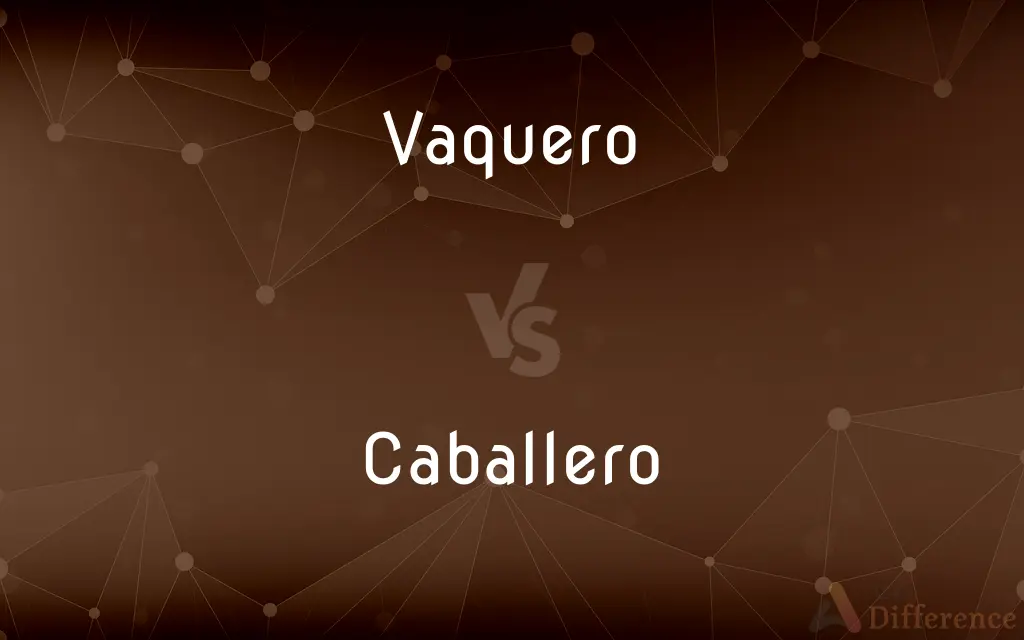Vaquero vs. Caballero — What's the Difference?
By Urooj Arif & Maham Liaqat — Updated on March 11, 2024
Vaquero refers to a cowboy or cattle herder, originating from Spanish-speaking regions, while caballero denotes a gentleman or knight, emphasizing chivalry and honor.

Difference Between Vaquero and Caballero
Table of Contents
ADVERTISEMENT
Key Differences
Vaqueros are skilled horsemen and cattle herders, foundational to the cowboy tradition in the American West, originating from Mexico and Spain. In contrast, caballeros are recognized for their chivalrous nature and gentlemanly conduct, often associated with the historic knights of Spain.
The vaquero tradition focuses on the practical skills of ranching, including roping, horse riding, and cattle herding. Caballeros, on the other hand, embody ideals of honor, respect, and noble behavior, which were especially relevant in medieval and early modern Spain.
Vaqueros are celebrated for their expertise in managing livestock and their ability to thrive in the harsh environments of the frontier. Whereas caballeros are often romanticized for their gallantry, bravery, and adherence to a code of ethics that valued honor above all else.
The attire of a vaquero is designed for functionality and protection in cattle herding, featuring wide-brimmed hats, boots, and chaps. Conversely, the traditional dress of a caballero was more about social status and might include fine fabrics, armor, or symbols of their knightly or noble standing.
While the concept of the vaquero is deeply rooted in the working-class culture of cattle herding, the caballero represents the upper echelons of society, where lineage, honor, and chivalrous acts defined one's status.
ADVERTISEMENT
Comparison Chart
Origin
Spanish-speaking regions, especially Mexico.
Medieval Spain.
Primary Role
Cattle herder and horseman.
Gentleman or knight, symbolizing nobility and chivalry.
Skills
Roping, riding, and livestock management.
Fencing, horseback riding, and upholding honor.
Cultural Significance
Essential to cowboy culture in the American West.
Associated with chivalry, honor, and nobility.
Attire
Functional gear including hats, boots, and chaps.
Often elaborate, reflecting social status and knighthood.
Compare with Definitions
Vaquero
Known for their practical ranching skills.
Vaqueros were essential in managing the large herds of the early West.
Caballero
Wears attire reflecting social status.
The caballero's cloak was made of the finest silk.
Vaquero
Originating from Spanish-speaking regions.
The traditions of the vaquero influence modern rodeo events.
Caballero
Associated with noble lineage.
The caballero's family was well known in the region for their valor.
Vaquero
Wears functional attire.
His vaquero outfit was perfectly suited for a long day of herding.
Caballero
Represents the ideal of noble behavior.
In stories. the caballero always fights for justice and honor.
Vaquero
A precursor to the American cowboy.
The American cowboy tradition owes much to the vaquero heritage.
Caballero
Embodies chivalry and honor.
As a true caballero. he upheld the highest standards of conduct.
Vaquero
A skilled horseman and cattle herder.
The vaquero expertly guided the cattle across the plains.
Caballero
A gentleman or knight. particularly in Spain.
The caballero offered his hand in a gesture of respect.
Vaquero
The vaquero (Spanish pronunciation: [baˈkeɾo], Portuguese: vaqueiro Portuguese pronunciation: [vaˈkejɾu]) is a horse-mounted livestock herder of a tradition that has its roots in the Iberian Peninsula and extensively developed in Mexico from a methodology brought to Latin America from Spain. The vaquero became the foundation for the North American cowboy.
Caballero
A Spanish gentleman; a cavalier.
Vaquero
See cowboy.
Caballero
A man who is skilled in riding and managing horses; a horseman.
Vaquero
(Southwestern US) A cowboy; a herdsman.
Caballero
A horseman, particularly in the Latin American context
Vaquero
One who has charge of cattle, horses, etc.; a herdsman; a cowboy.
Caballero
A Spanish gentleman.
Vaquero
Local names for a cowboy (`vaquero' is used especially in southwestern and central Texas and `buckaroo' is used especially in California)
Caballero
A Spanish line dance.
Caballero
A knight or cavalier; hence, a gentleman.
Common Curiosities
Can the term caballero have a modern usage?
Yes, caballero is still used in modern Spanish to refer to a gentleman, emphasizing respect and polite behavior.
What is a vaquero?
A vaquero is a skilled horseman and cattle herder, originating from Spanish-speaking regions and foundational to the cowboy tradition.
How did vaqueros influence American cowboy culture?
Vaqueros introduced cattle herding techniques and rodeo traditions to the American West, significantly shaping cowboy culture.
What is the significance of attire for vaqueros and caballeros?
Vaqueros wear functional attire for ranching, while caballeros' attire reflects their social status and chivalrous ideals.
Who is a caballero?
A caballero is a gentleman or knight in Spanish culture, known for chivalry, honor, and noble conduct.
Is being a vaquero considered a profession?
Yes, being a vaquero is a professional role, primarily in cattle herding and ranching.
What role do caballeros play in literature and film?
Caballeros often appear in literature and film as romantic heroes, exemplifying ideals of bravery and courtesy.
What ideals do caballeros embody?
Caballeros embody the ideals of chivalry, honor, and noble conduct, often associated with the historic knights.
How do caballeros fit into historical Spanish society?
Caballeros were part of the nobility or warrior class, with a focus on chivalry and martial prowess.
What skills are associated with vaqueros?
Vaqueros are skilled in roping, horseback riding, and managing livestock.
What are common misconceptions about caballeros?
A common misconception is that caballeros were only warriors; in fact, they were also expected to be cultured and virtuous.
Were caballeros actual knights?
Historically, caballeros were knights or noblemen, though the term has evolved to symbolize gentlemanly behavior.
Are there female equivalents to vaqueros and caballeros?
Historically, these roles were male-dominated, but women in similar roles exist, especially in modern interpretations and inclusive societies.
How has the image of the vaquero evolved over time?
The image of the vaquero has evolved from a regional cattle herder to a symbol of the rugged, independent cowboy ethos.
Do vaqueros still exist today?
Yes, modern vaqueros continue to work in cattle ranching and equestrian activities, especially in regions with strong Hispanic heritage.
Share Your Discovery

Previous Comparison
Follower vs. Following
Next Comparison
Abstractive vs. AbstractAuthor Spotlight
Written by
Urooj ArifUrooj is a skilled content writer at Ask Difference, known for her exceptional ability to simplify complex topics into engaging and informative content. With a passion for research and a flair for clear, concise writing, she consistently delivers articles that resonate with our diverse audience.
Co-written by
Maham Liaqat













































